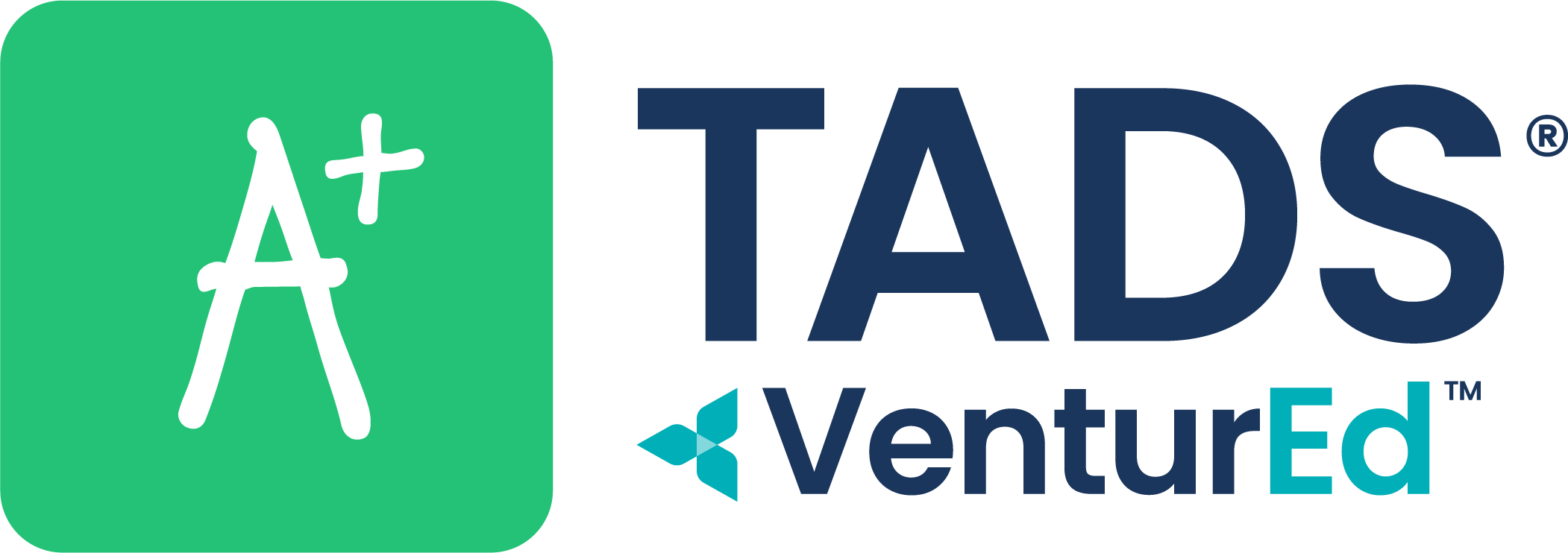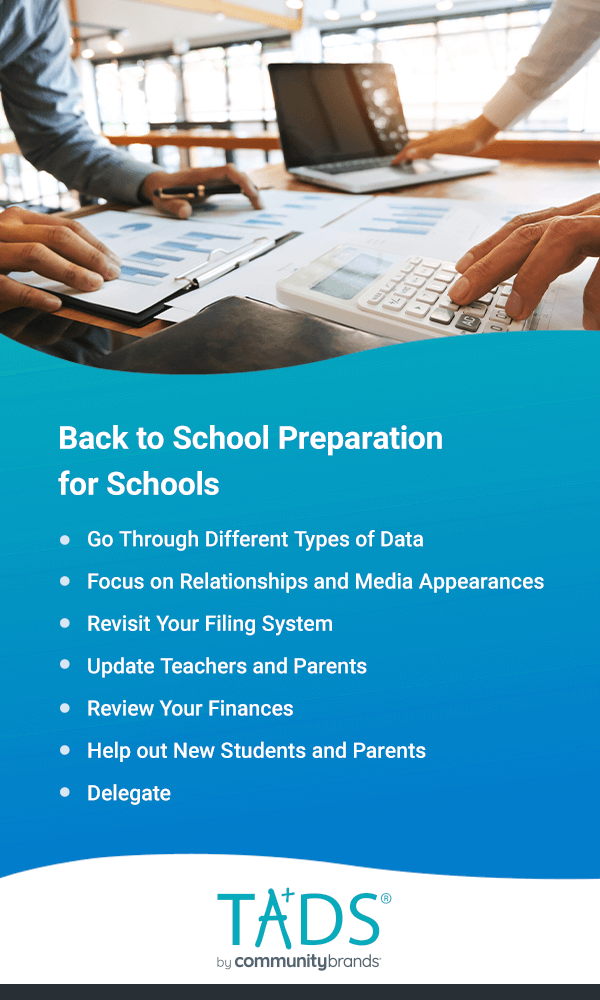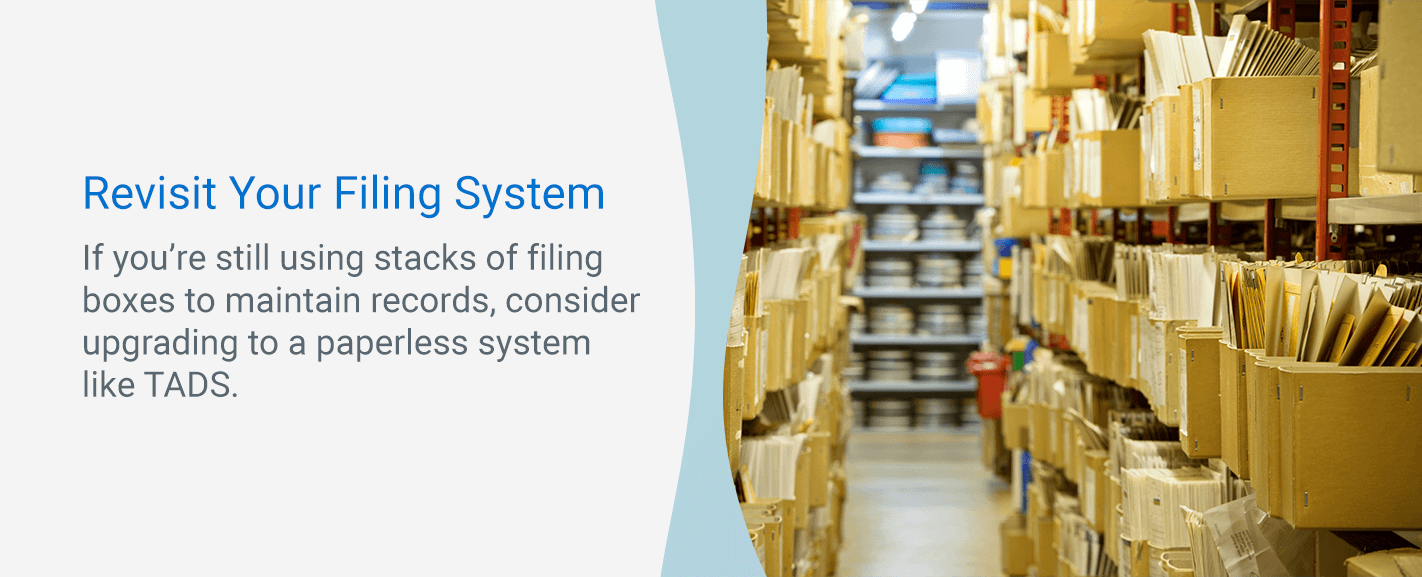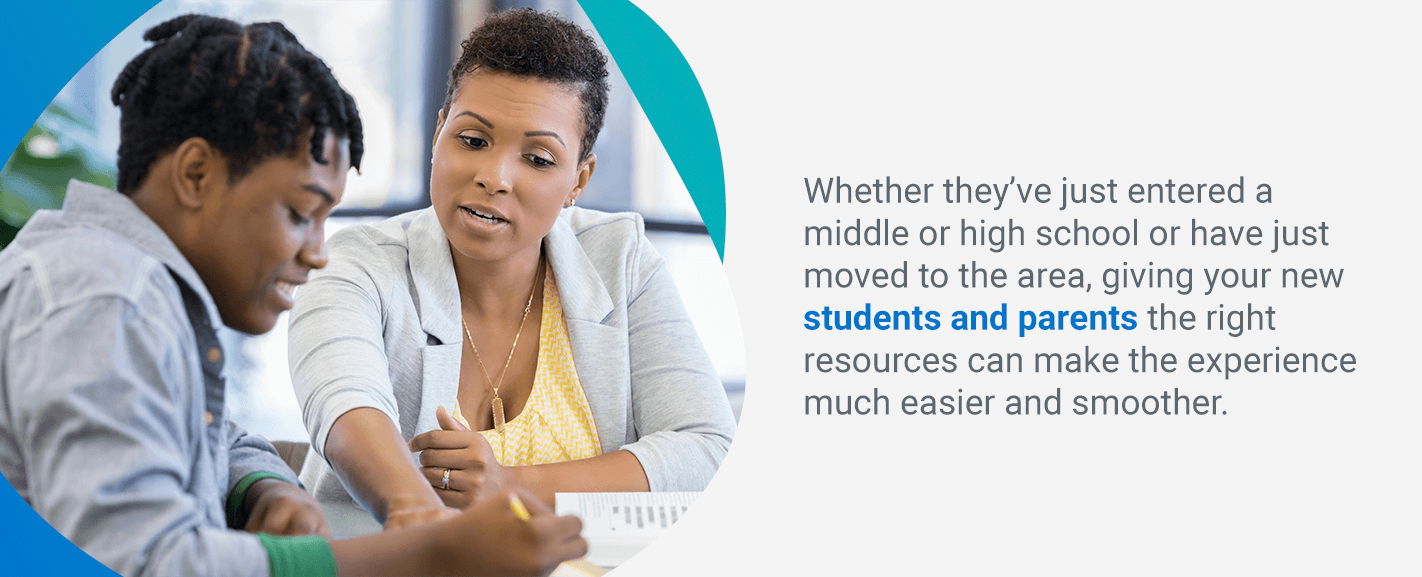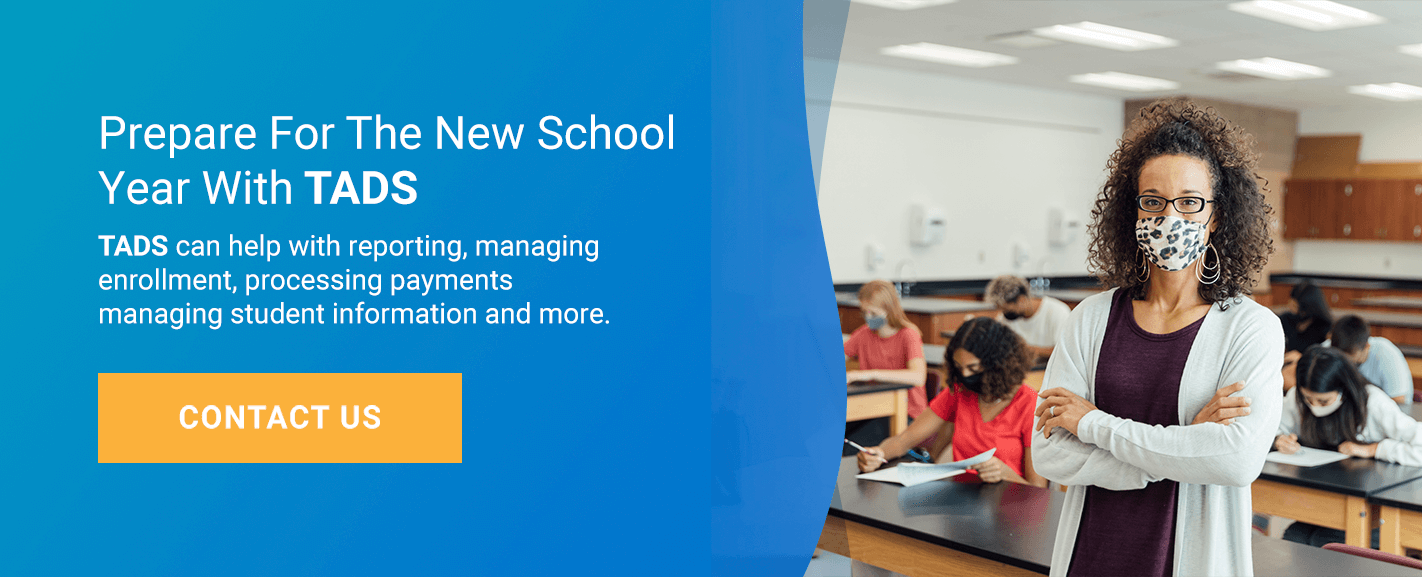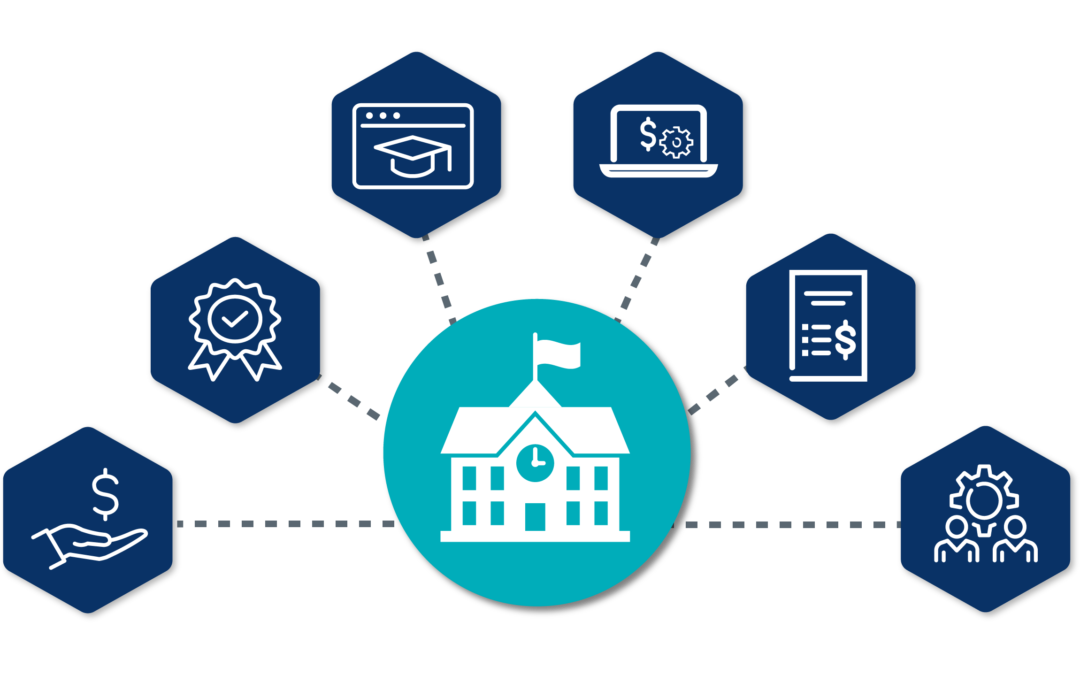
As the new school year rolls in, administrative offices are hard at work. You’re probably doing everything you can to make the next year as successful as possible, but that involves a lot of tasks. Aside from the necessities, there’s a sizeable amount of prep work you can do at the start of the year. Before deadlines start piling up, this is the best time to tackle some broader aspects and get classes off on the right foot.
From finances to signage, administrators can tackle many topics to deliver a better experience and education for students, families and teachers. To make it easier, we’ve put together a handy guide on how to prep for a new school year.
Back to School Preparation for Schools
Preparing for the new school year can include reviewing last year’s information, making school improvements, improving communications with students and updating your systems. Below are our top tips for how private schools should prep for a new school year.
1. Go Through Different Types of Data
If you’ve been keeping an eye on things, you’ve probably collected quite a bit of data over the last school year. Take a close look at it and spend some time understanding where you’re at and where you want to be. Is your data helping you meet your goals and come up with new ones? Are you collecting unnecessary data?
Look at your quantitative data, such as enrollment numbers, attendance data and achievement scores. Make sure you’re using the data you’re collecting effectively. Choose a few priorities to focus on and how relevant they are to your goals. If enrollment numbers are doing just fine, maybe start focusing on other types of data, like academic success scores. If you don’t already, ensure your management tools support data collection.
Don’t just focus on numbers, either. Collect and review qualitative data, such as conversations with students, parents and the parent-teacher association (PTA). They can provide valuable insights that you simply won’t get from numbers in a spreadsheet. Showing parents and the PTA that you value their input can also help you build stronger relationships with them.
2. Focus on Relationships and Media Appearances
Starting the school year right involves managing many relationships. Students and teachers, teachers and administrators, the school and parents — the list goes on. Spend some time assessing these relationships and take steps to support them. Identify areas that might need work.
Brainstorm opportunities to improve relationships. You can set up some team-building activities for teachers and administrators, meet up with students during lunchtime and chat with parents at a kickoff game. Involve administration in events and show your support for teachers and students.
A great place to do this is social media. Make sure your school’s social media accounts are putting the right image out there. It’s a great place to reach parents through the 86% of millennials that use Instagram and Twitter. Older students likely use those platforms as well.
Make some back-to-school posts and get people excited. Talk about your kickoff events, open houses and other events to get more community members in the door and set the right tone for the year. Consider providing resources for parents and students, like supply lists, reminders for form submission deadlines and back-to-school study tips. The new academic year is also a common time for account ownership to change hands, so ensure anyone in control of a school-affiliated social media account understands the guidelines and policies.
3. Revisit Your Filing System
If you’re still using stacks of filing boxes to maintain records, there’s definitely room for improvement. Paper-based filing systems are less secure, harder to use and less environmentally friendly than electronic management systems. If this is you, consider upgrading to a paperless system like TADS. TADS can help you manage different aspects of administration and school operations, including enrollment, grading, billing, student data, parent communications and background checks.
Going paperless can help you see some big benefits, such as:
- Reduced costs: Many schools save significantly on the costs of paper and toner when they switch to digital records. The sheer number of papers printed each week in schools can reach staggering amounts. This benefit is best seen on a school-wide level, but even small paperless switches can go a long way in reducing costs.
- Improved experience for parents: If your system offers a portal for parents, they see that their student will be attending a 21st-century school. They get to enjoy convenient features like online payments, cafeteria menus, notifications and access to their child’s grades at any time and any place. Just as they use their phones to manage their finances, shopping and social lives, they can also take care of important parenting tasks there, too.
- Improved experience for teachers: Many teachers enjoy the organizational and functional benefits that digital tools offer. They can keep grades straight and easily push out assignments, even if they’re working hybrid schedules. With an ever-evolving technical workforce, paperless platforms also allow them to build up their students’ IT skills.
- More organization: Let’s be honest — paperwork can get messy. Papers are easy to lose, easy to spill your morning coffee on and easy to mix up with all of the other papers you have to manage. Digital systems can eliminate stacks of file boxes, provide better security and recordkeeping, and make it easier to find what you’re looking for. If you decide to go paperless, you can also save space in the building and make it easier for teachers to tote assignments around.
- Better efficiency: Typing in the name of the document you’re searching for is a lot easier than sifting through folders and files. Plus, an email reaches parents much faster than snail mail. Going paperless is a great way to speed up the everyday tasks of administrators, teachers, parents and students.
- Eco-friendly operations: Paper waste is a huge problem in education, and going digital is a great way to reduce it. You get to help the planet and boast eco-friendly practices at the same time. There’s a growing demand for climate-friendly products, with 77% of Americans saying they are concerned about the environmental impact of the products they buy. It makes sense that these ideas would transfer over to the ideologies of the schools they choose to send their children to.
If you make the switch to a paperless system, the start of the school year is a great time to do it.
4. Update Teachers and Parents
Take some time during the start of the year to get everything up to speed on what’s changed while they’ve been hard at work during the prior school year.
With the new year comes new trends, policies and procedures. Make sure your online resources, like handbooks, forms and calendars, are updated to that school year’s documentation. If things have changed, such as face mask or lunch allergen policies, communicate them clearly. The same goes for teacher resources. Be sure to send out your master schedules and other updates. Do both of these tasks well ahead of the start of classes, so everyone has time to prepare.
To beef up your teachers’ professional knowledge and keep your school on the cutting edge, implement training and resources about industry trends and new research in pedagogy. Take 2020, for instance. Edutopia put together a list of 10 fascinating studies from that year that many teachers can use to inform stronger teaching practices. Some of these topics include:
- The value of acting: Students who acted out new foreign words were 73% more likely to remember the words than students who didn’t use the gestures. Encouraging the inner thespian in students can be a useful memory trick.
- The impact of rubrics on racial grading biases: When presented with a student paper mentioning a family member named either Dashawn or Connor, teachers were 13% more likely to give the papers with Connor a passing grade. When using a rubric, that difference virtually disappeared. Rubrics can be a valuable part of assignment clarity and working toward equality.
- How accessibility to virtual classrooms affects performance: While it seems simple, Georgia State University researchers found that logistical issues were the biggest obstacle toward successful virtual learning. By simplifying and centralizing communications, decluttering interfaces and conducting regular surveys on accessibility and ease of use, schools and teachers can better improve their virtual learning systems.
- Language and coding are closely related: After learning a programming language, students took tests on their problem-solving, math and language skills. Math skills only accounted for 2% of the ability to learn code, but language skills accounted for 17% — making them almost nine times as predictive. Many students are dissuaded or barred from programming courses if math isn’t their strong suit. This study shows that this attitude can exclude students with plenty of potential.
5. Review Your Finances
Financial teams are likely getting their ducks in a row for the new school year, but it’s also a good time to make sure your budget and financial tools are primed to support the school. Do all of your expenditures align with a goal and contribute to it effectively? Are your actual expenditures matching up to the planned expenditures? Are there areas where you expect an increase in spending this year over the last? Take a look at last year’s budget and really dig into where the money is going and where it’s coming from.
A good way to get more information on your finances is to use a financial management program that provides comprehensive back-end reporting. If you can drill down into the nitty-gritty of your income and expenses, you can better understand your budgets and gain valuable new insights. These insights often translate into sizable growth for the bottom line, so you can better give back to your students and create a successful educational environment.
Robust financial tools can also help you:
- Improve payment likelihood with delinquent reminders and easy online account management.
- Appeal to more families with payment options.
- Manage the variety of costs and fees you need to collect from families.
- Keep comprehensive records for years to come.
Spend some time assessing your financial platform and see if you can use it to make some beneficial changes. TADS offers tools for tuition and billing management and financial aid assessment for easier accounting.
6. Help out New Students and Parents
A new school can be nervewracking for incoming students and the concerned parents who want to make sure their kid adjusts well. Whether they’ve just entered a middle or high school or have recently moved to the area, giving your new students and parents the right resources can make the experience much easier and smoother. The simple task of providing information can turn a frightening first week into a fun one. Older students and the parents of young children can get many resources from a well-executed website or online portal — TADS can help you get those, too.
Some things you can provide students and parents with include:
- Information on parking and bus loading schedules.
- Laptop rental or purchase information.
- How to buy lunch with a school ID.
- Housing rules, if the school has live-in dormitories.
- Supplies lists.
- A map of the school and signage within the building.
- How to access support structures like counseling, tutoring and communicating with administrators and teachers.
- What to do if the student loses their school ID, needs to get in the building after school starts or finds themselves in other tricky situations.
- Events throughout the year, like homecoming and spirit week.
If you don’t already have these resources easily accessible, consider adding them somewhere that parents and students can get to them without reaching out to the administration. Easy access means they don’t need to bother your team and can get the information they need at any time of day — even if it’s at 9 p.m. the night before classes start.
7. Delegate
Not everything needs to fall on administration. There are many topics you can delegate out to committees and teams. You might have a homecoming committee, a teacher experience committee or a mental health committee. Even something as simple as a “happiness” committee can be dedicated to spreading cheer throughout the school.
Committees are a great way to both lessen the burden on the administration team and involve more people in decisions. You can give students, teachers and parents a voice and help them be heard when it comes to making things happen.
How TADS Can Help
Implementing the changes you want to make is difficult without the right resources. TADS offers a comprehensive collection of tools designed for the many aspects of school administration and family access. On the administration side of things, TADS can help with reporting, managing enrollment, processing payments managing student information and more. For families, TADS offers features like application submission, easy payments, online grade access and ongoing communication with the school.
We know that when it comes to education, one size does not fit all. That’s why we’ve made TADS able to accommodate the unique needs of your school. Whether you want the complete package or just a few tools, we can help. To learn more about TADS and see what it could look like in your school, please reach out to a knowledgeable representative today to request a demo.
